| > Peter Wright | > Dick White |
| > James Jesus Angleton | > Anthony Blunt |
| > Kim Philby | > Goronwy Rees |
| > Roger Hollis |
Peter Wright
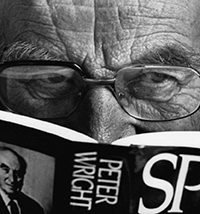
Peter Wright
MI5’s Principal Scientific Officer, then Head of D3 Research and Chairman of the joint MI5/MI6 working party that was established in 1964 to hunt for ‘moles’ inside the British intelligence services, government, civil service, the military and academia. The portrait that emerges from his memoirs is of a man blinded by prejudice, resentful of his superiors, intoxicated by his own position and influence, and so obsessed with the Soviet threat, so determined to prove a grand conspiracy, he was prepared to lie and make up evidence to prove his case. It was ‘up to us to stop Russians getting control of the British government’, he said in 1988, and as far as he was concerned, how he went about that task was a matter for him and no one else. Read his own account of his activities in ‘Spycatcher’.
James Jesus Angleton
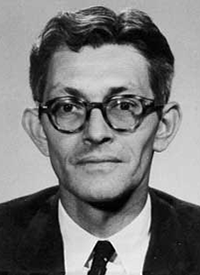
James Jesus Angleton
The CIA’s Chief of Counterintelligence for more than twenty years, he exerted a powerful influence on the spy catchers at MI5, especially Peter Wright. Angleton was convinced the Soviet Union had built an extensive network of spies in America and Europe and was winning the Cold War. As head of counterintelligence he was paid to be the most suspicious man in the CIA, but by the 1960’s his obsessive pursuit of the ‘enemy within was out of control. The innocent were accused; CIA efficiency was undermined. Angleton was lost in ‘a wilderness of mirrors’, where no one could be trusted, and nothing was what it seemed. For more information click here, ‘The James Angleton Phenomenon’ https://www.cia.gov/library/center-for-the-study-of-intelligence/csi-publications/csi-studies/studies/vol53no4/201ccunning-passages-contrived-corridors201d.html, to read the CIA’s own assessment of its counterintelligence chief.
Kim Philby
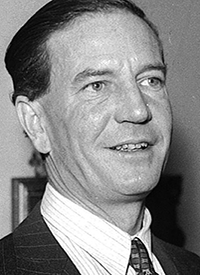
Kim Philby
The Westminster School, Cambridge University educated, clubbable philanderer and cricket obsessive who became a communist and perhaps Britain’s ‘greatest traitor’. Recruited in 1934 by Soviet agent, Arnold Deutsch, code name OTTO, he was instrumental in the recruitment of his university friends, Guy Burgess and Donald Maclean. Philby provided a constant flow of intelligence to his handlers before and during the war, but it was in the years immediately following that he was to prove of most use to the Soviet Union. In 1949 he became Britain’s principal intelligence officer in the United States with access to the secrets Washington was prepared to share with its ally in London. The defection of Burgess and Maclean in 1951 ended his career in MI6, but he remained on good terms with many of its senior officers. Armed with fresh evidence from a defector and one of Philby’s old girlfriends, British intelligence finally moved against him in 1963, but it was too late: Philby was ‘exfiltrated’ to the Soviet Union before he could be arrested and debriefed. Listen to Philby lying to the Press in November 1955 when Burgess and Maclean appeared in public in Moscow https://www.youtube.com/watch?v=N2A2g-qRIaU
Roger Hollis
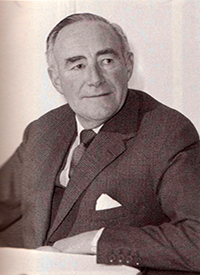
Roger Hollis
The Director General of the Security Service (MI5) from 1956-65, and the only man to hold the post to authorise an investigation of himself. The spy catchers at MI5, Arthur Martin and Peter Wright, believed he was the double agent, code name ELLI, at the top of British intelligence. Their investigation produced no concrete evidence, and entirely ignored his role during the Second World War in alerting the Service for the first time to the threat of Soviet penetration. Hollis was questioned in 1971 and cleared, and by a government review of the evidence four years later. Wright refused to accept its findings. An internal report carried out by a senior MI5 officer in 1988 dismissed the case against Hollis and accused Wright of fabricating or distorting evidence to fit his conspiracy theories. Wright detested Hollis, and the personal animosity he felt for him clouded his judgement. Sir Roger Hollis was not an inspiring Director General or a great judge of character. It was his decision to make a Science Officer with no real experience of counter-intelligence investigations head of D3 Research at MI5: Peter Wright had the licence he needed to pursue his vendetta.
Dick White
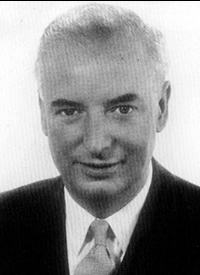
Dick White
Served as both Director General of MI5 and Chief of MI6 until 1968, the only intelligence officer to do so. His appointment to both positions owed a great deal to his popularity in Whitehall, where he was regarded as genial, professional, not a brilliant officer, but a ‘safe pair hands’. But White was too easily persuaded by the MI5 spy catchers and James Angleton at the CIA that the Soviets had agents at the heart of the British Establishment, in government, the civil and intelligence services, and academia. With White’s support Peter Wright embarked on a ‘witch hunt’ for former Communists and their associates, and when his predecessor at MI5, Roger Hollis, was entangled in the spy catcher’s net, he failed to challenge and dismiss the evidence.
Anthony Blunt
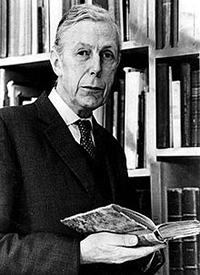
Anthony Blunt
Renowned art historian and aesthete, Surveyor of the Queen’s Pictures, pillar of the Establishment and Soviet spy. Blunt was one of the ‘Ring of Five’ associates recruited at Cambridge in the 1930’s. Blunt worked as a talent spotter at the university and was responsible for the recruitment of at least one of the five and a number of other key Soviet spies. During the war he was recruited to MI5 and used his position to pass hundreds of pieces of intelligence to Moscow. Suspicion about his role was aroused when two of the five, Guy Burgess and Donald Maclean, escaped to Moscow in 1951, but it was another twelve years before MI5 had the proof it needed to wring a confession from him. In return for agreeing to co-operate, Blunt was granted immunity from prosecution and his gilded life as Knight of the Realm, royal servant and respected art historian continued as before. That changed in 1979 when his role as a Soviet spy was confirmed by Prime Minister, Margaret Thatcher and he was stripped of his Knighthood.
Goronwy Rees
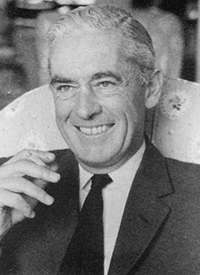
Goronwy Rees
Writer, journalist, academic, and briefly a spy, Rees’s story is entwined with that of his friend, Guy Burgess, a member of the ‘Ring of Five’. Rees had spent time in Berlin and was disgusted by the new Nazi regime. Like many university intellectuals in the 1930’s he championed a Marxist vision of a more equal society and redistribution of wealth, and he looked for an example to the Soviet Union. For a time, he was prepared to supply Burgess with information in the full knowledge that his friend was a spy. Rees left the Communist Party in 1939 when the Soviet Union made common cause with the Nazis, but he made no mention of Burgess’s espionage activities even when he was working for MI6. Burgess defected in 1951 and Rees was interviewed by MI5: why had he kept Burgess’s secret? Was he a ‘traitor’ too? Rees denied it and wrote a series of anonymous articles for a tabloid newspaper justifying his own behaviour and detailing his erstwhile friend’s ‘treachery’ and ‘sordid’ private life. Scandalised by the pieces, Aberystwyth University forced him to resign as its Principal, and he lost many friends.
